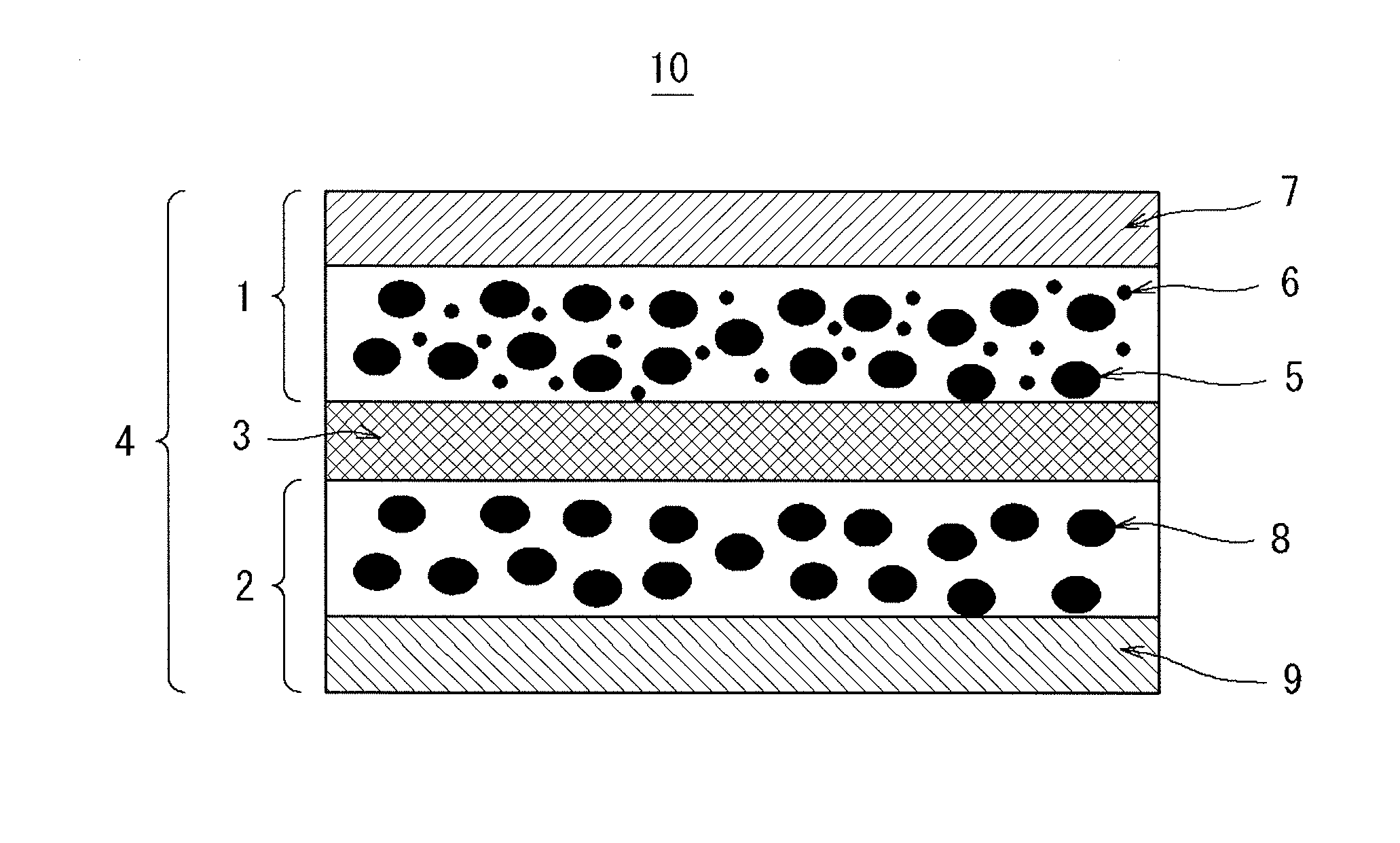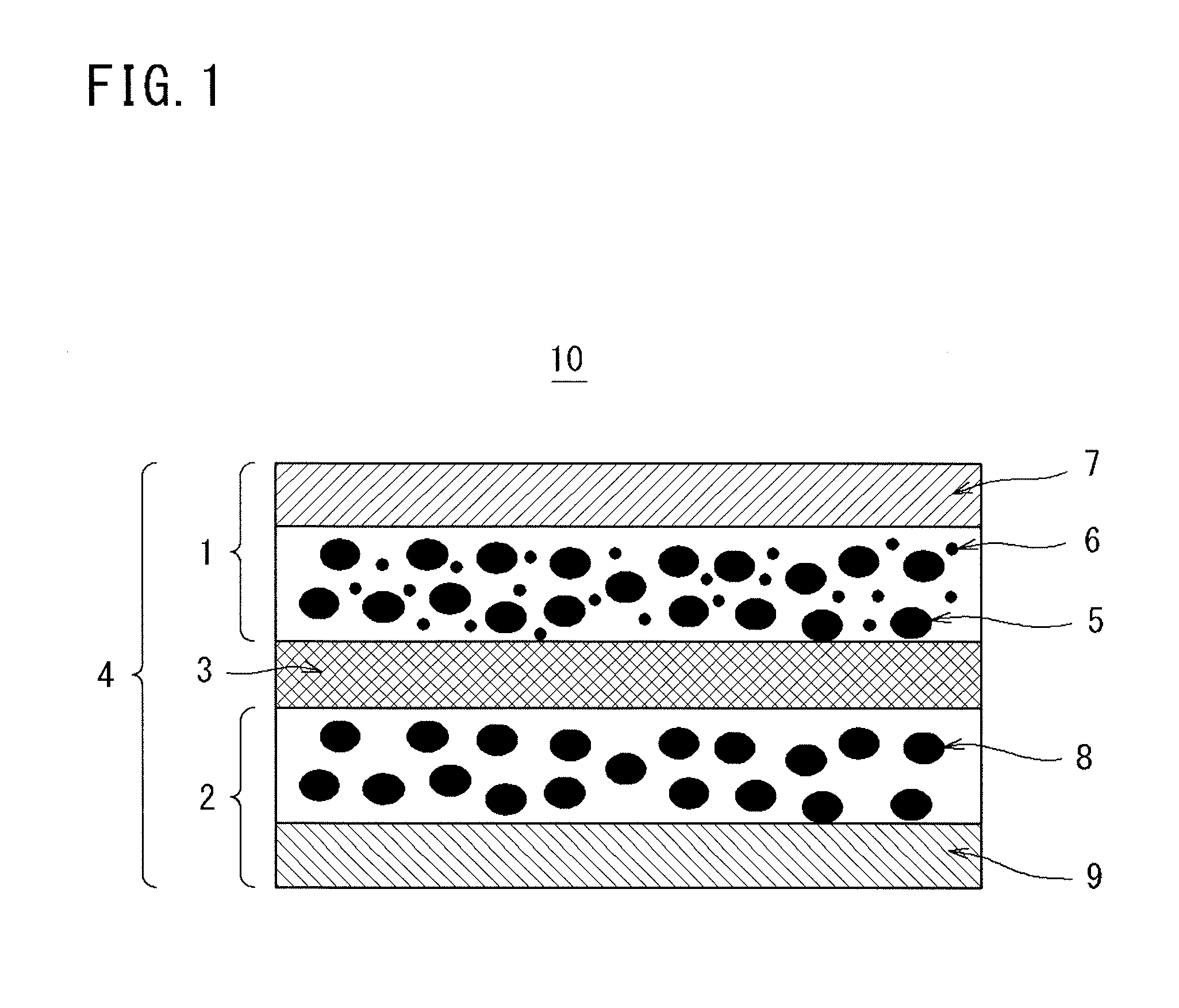Metal three-dimensional network porous body for collectors, electrode, and non-aqueous electrolyte secondary battery
- Summary
- Abstract
- Description
- Claims
- Application Information
AI Technical Summary
Benefits of technology
Problems solved by technology
Method used
Image
Examples
example 1
Production of Aluminum Porous Body 1
[0134](Nonwoven fabric)
[0135]A nonwoven fabric (thickness: 1 mm, degree of porosity: 94%, weight of nonwoven fabric per unit area: 60 g / m2, 30%-cumulative pore diameter (D30): 32 μm) was obtained, by using a PP / PE core-in-sheath composite fiber (fiber length: 10 mm, fiber diameter: 2.2 dTex (17 μm), core-sheath ratio: 1 / 1).
(Formation of Conductive Layer)
[0136]By a sputtering method, a film was formed by depositing, on the surface of the resulting nonwoven fabric, aluminum at a weight per unit area of 10 g / m2, to form a conductive layer.
[0137](Molten Salt Plating)
[0138]The nonwoven fabric which had the conductive layer formed on the surface thereof was used as a workpiece. After the workpiece was set in a jig having an electricity supply function, the jig was placed in a glovebox maintained with an argon atmosphere and a low moisture condition (dew point: −30° C. or lower), and immersed in a molten salt aluminum plating bath (composition: 33 mol % ...
example 2
Production of Aluminum Porous Body 2
[0142]An “aluminum porous body 2” was obtained by performing the same operation as in Example 1 except for using, as the nonwoven fabric, a nonwoven fabric (thickness: 1 mm, degree of porosity: 97%, weight per unit area: 30 g / m2, 30%-cumulative pore diameter (D30): 142 μm), the nonwoven fabric being obtained by using a PP / PE composite fiber (fiber length: 50 mm, fiber diameter: 4.4 dTex (25 μm), core-sheath ratio: 1 / 1).
[0143]The degree of porosity of the “aluminum porous body 2” was 94%. The 30%-cumulative pore diameter (D30) of the “aluminum porous body 2” was 130 μm.
example 3
Production of Copper Porous Body 1
[0150]By a sputtering method, a conductive layer was formed by depositing copper at a weight per unit area of 10 g / m2, on the surface of the nonwoven fabric used in Example 1. Next, a copper plating layer (weight of copper per unit area: 400 g / m2) was formed by an electroplating method on the surface of the nonwoven fabric, thereby giving a “copper-resin complex porous body 1”. The resulting “copper-resin complex porous body 1” was heated to remove the nonwoven fabric through incineration. Then, the resulting product was heated in a reducing atmosphere to reduce the copper, thereby giving a “copper porous body 1” consisting of copper.
[0151]The degree of porosity of the “copper porous body 1” was 96%. The 30%-cumulative pore diameter (D30) of the “copper porous body 1” was 30 μm.
PUM
 Login to View More
Login to View More Abstract
Description
Claims
Application Information
 Login to View More
Login to View More - Generate Ideas
- Intellectual Property
- Life Sciences
- Materials
- Tech Scout
- Unparalleled Data Quality
- Higher Quality Content
- 60% Fewer Hallucinations
Browse by: Latest US Patents, China's latest patents, Technical Efficacy Thesaurus, Application Domain, Technology Topic, Popular Technical Reports.
© 2025 PatSnap. All rights reserved.Legal|Privacy policy|Modern Slavery Act Transparency Statement|Sitemap|About US| Contact US: help@patsnap.com



